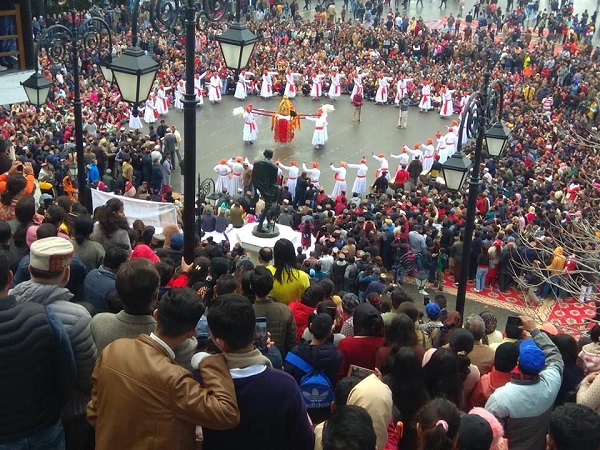
Shimla, A rare glimpse of deity culture is being witnessed these days mostly in interiors of Himachal Pradesh as highly revered Domeshwar devta is on his sojourn, once in two decades, travelling village to village with his followers in a tastefully decorated palanquin amid the sounding of trumpets and drums
Two days ago, a sea of devotion, comprising Cabinet ministers, including Suresh Bhardwaj, and High Court Chief Justice L. Narayana Swamy along with other judges, was seen in the state capital where tens of thousands gathered in the historic Ridge to get his blessings and participate in typical ‘choltu’ dance.
The followers — all males — were dressed up in white robes donning saffron turbans.
The seat of Domeshwar Devta is Guthan near Theog in Shimla district.
After two days of sojourn in Shimla city, the ‘devta’ on Tuesday left for the next destination.
The ‘devta’ visited Shimla to bless locals after a gap of 20 years, Tulsi Raman, a noted local literary figure, said.
According to him, Domeshwar devta is highly revered in Shimla and Solan districts and is on sojourn for many months.
Octogenarian and local resident Ram Lal Manta told IANS such divine congregations help understanding the symbiotic relationship between the humans and the divine.
Madan Lal Verma, a caretaker of Domeshwar devta, said during the journey, the place of stay, its duration and the deity dance are predetermined.
Himachal Pradesh is also popularly known as the ‘Devbhoomi’ — the land of gods.
Every village has several resident ‘gods’ and ‘goddesses’ — who are invoked as living deities.
The conduit between the mortals and the deities are the ‘gur’ — the traditional shamans, who form the core of the communities’ spiritual sustenance.
The ‘devtas’ accept invites of their followers and moves to various locations at their wish. Sometimes they decide to undertake a pilgrimage. Some do so after one-two years, others do so after 30 to 40 years and some embark on special pilgrimage after hundreds of years.
The ‘devtas’ travel only on foot and use old track routes. They avoid travelling through tunnels.
Interestingly, the water level in the Larji hydropower project in Kullu is brought down every year for the “safe passage” of deities to participate in the traditional Kullu Dussehra festival.
Making the waters recede help restoring the traditional track used by the gods and goddesses from the interiors of Ani, Banjar and Nirmand divisions to reach Kullu town.
According to “A reference book on Kullu Devtas” compiled by the Kullu administration, there are 534 “live” gods and goddesses in the picturesque Kullu Valley.
Six-time Chief Minister Virbhadra Singh, in his foreword in the book, wrote he fondly recalled that as a member of Parliament from Mandi in the 1970s he used to dance the whole night in front of the tents of the assembled ‘devtas’ during the Kullu Dussehra.
“The dance continued from dawn to dusk with hundreds of people swaying to the divine music. Such is the spirit of Dussehra,” he wrote.
The book says the affairs of the Kullu gods are managed by the ‘devta’ committees that comprise a ‘kardar’ or manager of the temple, the ‘gur’ or oracle, musicians and a priest.
The ‘devta’ summons the ‘gur’ and speaks through him.
The oracle goes into a trance and connects with the deity. The deity’s wish spreads and its followers are ready to obey the sacred command. One member of each family has to join the deity’s procession.
The book says the long and tough journeys are to be performed on foot. It takes days, even months. Strict rules and rituals have to be followed. The deity sets the time and pace of the journey. No one can lift the palanquin of the deity if he/she is not willing.







